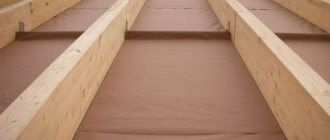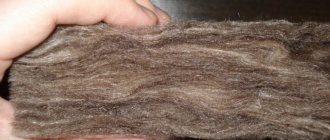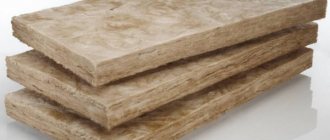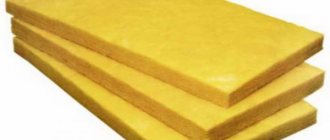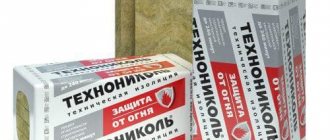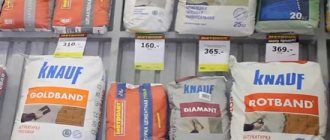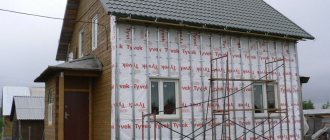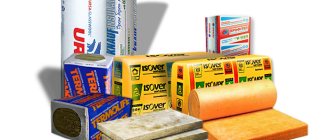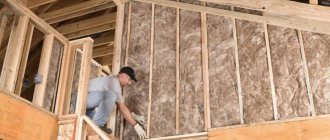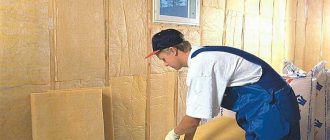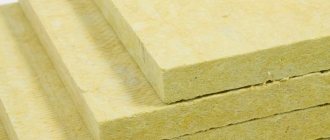Stone wool is a type of insulation made from gabbro-basalt rocks, which allows for thermal and sound insulation of various structures or fire protection.
Due to its physical and chemical properties, this type of insulation serves as the main energy-saving technology for finishing facades, roofs, floors and utility networks of both industrial, semi-industrial and domestic facilities.
Stone mineral wool production technology
The production of mineral (basalt) wool involves melting rocks at a temperature of 1500 C. After which, the liquid lava-like mass is drawn into stone fibers using a centrifuge, special filters based on platinum or other heavy-melting metals and strong air currents.
Next, various water-repellent additives and plasticizers are added to the resulting fibers, after which, at a temperature of about 200 C, a polymerization process occurs, as a result of which equipment for the production of mineral wool produces ready-made basalt slabs, which are cut according to the required dimensions.
What will be required for implementation?
Before you start implementing a business idea, you need to draw up a competent plan, which should include the following points:
- analysis of the sales market, competition;
- main investments for opening production;
- step-by-step description of the entire technological process;
- preliminary calculations of production profitability, costs, net profit.
In addition to business planning, it is necessary to pay attention to the search and rental of production premises, suppliers of raw materials, personnel, and advertising.
Chemical composition of stone wool
Since the production of thermal insulation materials of this class is carried out exclusively from rocks, the resulting basalt fibers have the following chemical composition:
- Silicon dioxide SiO2 in an amount from 45 to 55%.
- Titanium dioxide TiO2 with a mass fraction from 1.36 to 2%.
- Calcium oxide CaO in an amount from 7 to 11%.
- Iron oxides FeO and Fe2O3 with a mass fraction from 5.38 to 13.5%.
- Manganese oxide MnO in the range of 0.25 to 0.5%.
- Aluminum oxide Al2O3 with a percentage of 14 to 20%.
- Manganese oxide MgO in an amount from 3 to 8%.
- Sodium and potassium oxide (Na2O, K2O) in amounts from 2.7 to 7.5%.
- Other substances make up no more than 5%.
All of the above oxides are bonded to each other using bitumen, synthetic or composite binders, or using bentonite clay.
The main indicator of the quality of the resulting basalt fiber is the acidity modulus, which depends on the ratio between acidic and basic (meadow) oxides. Its value is regulated in accordance with the requirements of GOST 4640-93 “MINERAL WOOL. Technical conditions".
According to the above document, stone wool is divided into 3 categories:
- Category “A” with an acidity modulus of 1.6 and above.
- Category “B” with an acidity modulus in the range from 1.4 to 1.6.
- Category “C” with acidity modulus below 1.4.
As can be seen from the above categories, the higher the acidity modulus, the higher quality the basalt wool is, since it is more durable and moisture resistant.
Very often, to regulate the above indicator, manufacturers use various additives based on carbonate compounds.
Staff
Don't skimp on employees. You need competent and highly qualified personnel with experience in a similar field.
Average salaries in the region according to hh.ru:
- Technologist, 1 person – 40,000 rubles
- Locksmith, 2 people - 50,000 rubles
- Equipment adjuster, 1 person – 30,000 rubles
- Loader, 2 people – 40,000 rubles
- Total - 160,000 rubles
The business owner handles bookkeeping and payroll in order to save money. Over time, you can hire an accountant or outsource his services.
Types and scope of application of basalt fibers
Equipment for the production of mineral wool allows us to produce the following types of stone (basalt) fiber:
- Microfine fibers for the manufacture of fine filters for air or liquid media with fiber diameters less than 0.6 microns.
- Ultra-thin stone fibers are used in fine filters for air, gas or liquid media, or in the production of ultra-light sound and heat insulating materials with fiber diameters in the range from 0.6 to 1 micron.
- Superthin (microcrystalline) basalt fibers are used for the manufacture of heat and sound insulating waterproof products (mats or rolls), various bundles and filters. This type of fiber is considered the most popular because, thanks to special heat treatment, the resulting microcrystals are able to withstand temperatures 200 C higher than previous types of fibers. Also, super-thin microfiber (diameter from 1 to 3 microns) does not shrink during operation, which significantly increases the range of applications of this material.
- Thin mineral-based fibers are chaotic structures with fiber diameters ranging from 9 to 15 μm. The length of individual fibers ranges from 3 to 2000 mm. This material is widely used in coarse filters, as well as in the production of mineral insulation for industrial needs.
- Thickened stone fibers are most often used as the main filtration systems for drainage systems. The thickness of this type of fiber ranges from 15 to 25 microns, and the length from 5 to 1500 mm.
- Thick fibrous structures are chaotically arranged fibers with a diameter of 25 to 150 microns and a length of one fiber from 0.05 to 3 m. Thanks to this, the resulting material can withstand enormous tensile loads of up to 650 MPa.
- Coarse fibers are a dispersive fibrous mass of fibrous structures with a thickness of 150 to 500 microns. This type of insulation can be used as a reinforced layer using special binding elements.
Marketing and sales channels
The best marketing is honesty. Most people, given the alternative of choosing between a cheap and safe material, will prefer the second. Based on this, a large inscription on the packaging “ECO”, “environmentally friendly”, “eco-friendly” is good advertising.
For these words to be true, it is necessary to import raw materials from quarries that do not contain granite or radioactive shale rocks. And the manufacturing technology of mineral wool itself assumes resistance to fire and the release of toxic substances.
The main consumers of mineral wool are organizations specializing in suburban construction. It is necessary to rely on attracting them for ongoing cooperation.
One of the most effective advertising moves can be considered creating your own website. This will help in finding customers interested in purchasing large quantities of goods and long-term cooperation.
Scope of application of basalt (stone) wool
Due to the fact that stone wool is a natural, non-flammable and durable material (since it consists of 95% natural stone), it has been widely used in construction since the beginning of the 20th century.
Due to its excellent properties, which include reducing thermal energy losses during the cold period, and reducing the entry of thermal energy into the building in the summer, stone wool is widely used in the following areas:
- When insulating building facades followed by plastering or installing siding or profile sheets.
- When insulating a room from the inside (balconies, loggias, external walls, etc.).
- When constructing partitions from gypsum plasterboard sheets in apartments, industrial or office buildings for sound insulation.
- When insulating the base of the floor and then pouring the screed.
- For soundproofing floating floors.
- When installing roofing or insulating attic floors.
- For fire protection of engineering structures and networks (this material can withstand temperatures up to 700 C).
How to advertise a business
Your own business card website, publishing ads on free websites and advertising in specialized publications are the main ways to advertise your products.
The most optimal of them is your own website. There you can display all the necessary information and set your target. The minimum costs for website development start from 10,000 rubles, for advertising - about 15,000 rubles, depending on the circumstances.
Advantages of stone wool (basalt insulation)
High chemical resistance. Thanks to this property, the material does not react with alkalis and acids and has increased resistance to petroleum products and solvents.
Porous structure. Due to this property, fibers make up only 70% of the total volume of the material. The rest are layers of air, which provide low thermal conductivity of the resulting material.
Fire resistance. This property makes it possible to insulate both steam pipelines and industrial equipment at high temperatures. Since the material is made from natural stone, it can withstand temperatures up to 7000C.
High vapor permeability. Thanks to this property, the material does not absorb, but rather allows moisture to pass through without the formation of condensation.
What are the recommendations for installing mineral slabs?
When installing mineral wool, use the following tips from experienced builders:
- To insulate a simple flat roof, lay mineral slabs in two layers. The fact is that in winter the roof freezes the hardest and will require additional protection.
- For soundproofing coating of wooden structures, use cotton wool with granules.
- To create “wet” type heat-insulating insulation, use laminated mineral wool.
- If you are making a roof with water drainage, buy a slab with a variable cross-section.
- When marking slabs, use a pencil. This will make cutting and measuring much easier.
Main manufacturers of stone wool
In the modern market, there are 3 main manufacturers of basalt-based mineral wool:
- TechnoNIKOL.
- Knauf.
- Rockwool.
Mineral wool TechnoNIKOL
This material is used for heat and sound insulation of facades, roofs, partitions and process pipelines. The density of this material ranges from 30 (ROCKLIGHT and TKHNOLIGHT Extra) to 145 kg/m3 (TECHNOFAS).
In the modern Russian market, this product is represented by the following varieties:
| Name | Nominal density, kg/m3 | Thermal characteristics, W/m*0С | Application area |
| ROCKLIGHT | 30 | 37-41*10-3 | Thermal insulation of walls and partitions indoors, insulation of pitched roofs and floors on joists |
| TECHNOLITE EXTRA | 35 | 36-41*10-3 | Installation of sound and heat insulation of partitions of office and domestic premises |
| TECHNOFAS | 145 | 36-42*10-3 | Insulation of facades before subsequent plastering or finishing with siding |
| TECHNOFLOOR | 90-170 | 34-47*10-3 | Insulation of floating, heated or self-leveling floors followed by installation of cement-sand screed |
| TECHNORUF | 140-190 | 36-42*10-3 | The main thermal insulation layer for new construction or reconstruction of roofing without the need for subsequent screed |
| TECHNOBLOCK STANDARD | 45 | 34-39*10-3 | Insulation and sound insulation of all types of buildings and structures in which the insulation layer is not subject to high static loads |
| TECHNOVENT STANDARD | 80-90 | 33-40*10-3 | Installation of ventilated facades |
Basalt wool Knauf
Knauf stone wool is an effective heat and sound insulation based on rocks, which has high vapor permeability and chemical resistance to acids, meadows and petroleum products.
On the Russian market, this material is produced under the Knauf Insulation brand and is represented by the following assortment:
| Name | Nominal density, kg/m3 | Thermal characteristics, W/m*0С | Application area |
| Insulation DDP | 150-200 | 40*10-3 | Insulation and sound insulation of a flat roof, the angle of inclination of which does not exceed 150 |
| Insulation DDP-K | 105-110 | 37-41*10-3 | Insulation and sound insulation of flat roofs, the angle of inclination of which does not exceed 150, as well as for insulation of floating floors |
| Insulation FKD | 140-150 | 39*10-3 | Insulation of external building facades or installation of ventilated facades |
| Insulation FKD-S | 100-140 | 36*10-3 | Insulation of external walls and construction of bonded facades |
| Insulation FKL | 85 | 40*10-3 | External wall insulation before siding installation |
| Insulation HTB | 35-150 | 37-39*10-3 | Insulation of utility networks, pipelines and air ducts with temperatures from -180 to 7000C |
| Insulation LMF AluR | 35-90 | 40*10-3 | Insulation of utility networks, pipelines and air ducts with temperatures from -180 to 7000C |
| Insulation PVT | 175 | 40*10-3 | Insulation of floors and floating floors |
| Insulation WM 640 GG/WM 660 GG | 80-100 | 35*10-3 | Insulation of process equipment and pipelines |
| Insulation cylinders | 75 | 40*10-3 | Technical insulation of utility networks and pipelines |
Rockwool basalt wool
Rockwool's products are highly efficient hydrophobized mineral slabs made from basalt rock with the addition of special additives to improve technical characteristics.
The company offers the following range in Russia:
| Name | Nominal density, kg/m3 | Thermal characteristics, W/m*0С | Application area |
| EPIROCK | 20 | 45*10-3 | Insulation of ventilated floors, as well as wooden floors on joists |
| ROCKROLL | 22 | 44*10-3 | Insulation of ventilated floors, as well as wooden floors on joists |
| ROCKSLAB ACUSTIC | 50 | 36*10-3 | Soundproofing of ceilings and partitions of premises for various purposes |
| ROCKSLAB | 26 | 42*10-3 | Insulation of walls, ceilings and floors without loading the stone wool layer |
| STEPROCK HD | 140 | 39*10-3 | Insulation of building structures and floors with high dynamic loads |
| ROCKMIN | 26 | 39*10-3 | Construction of a non-loaded thermal insulation layer |
| STEPROCK HD4F | 140 | 39*10-3 | Device of dynamic modulus of elasticity for industrial and residential buildings |
| FRONTROCK S | 110 | 39*10-3 | Insulation of facades of buildings and structures with subsequent application of a reinforced layer and plaster |
| MONROCK MAX E | 115-220 | 37*10-3 | Insulation of all types of floors without the need for subsequent installation of cement-sand screed |
| FIREROCK | 80 | 42*10-3 | Thermal insulation of the surface of fireplaces and technological equipment |
conclusions
Equipment for the production of mineral wool allows us to produce highly effective insulation for any type of premises, as well as provide reliable heat and sound insulation of both the roof, floors and walls.
On the modern market you can find a wide variety of mineral insulation materials based on basalt rocks, which not only have high technical characteristics, but also provide fire resistance to process pipelines in accordance with international standards.
Installation methods
Mineral wool slabs are installed in two ways: dry and wet . The first involves laying slabs in the gap between the wall and the sheathing. For this, a wooden or metal frame is created. The insulation is laid in the spaces between the profiles. The wet method is gluing slabs onto the wall surface, followed by applying a primer and mesh reinforcement. Installation of mineral wool cylinders is carried out using self-adhesive tape or thin wire.
TOP 15 questions from thermal insulation buyers and answers to them
We receive many questions on the topic: thermal insulation, sound insulation, fire protection, etc. We have selected the most frequently asked questions and formulated answers to them. Questions and answers from Basalt-Most:
1. What are the advantages and disadvantages of insulation with flax, hemp, and seaweed? Flax, hemp, and dry algae are flammable materials, but in order to give them the property of self-extinguishing when exposed to fire, they are treated with anti-foam compounds - boron compounds. The same applies to “Ecowool” (that’s what finely torn newspapers are called for some reason).
